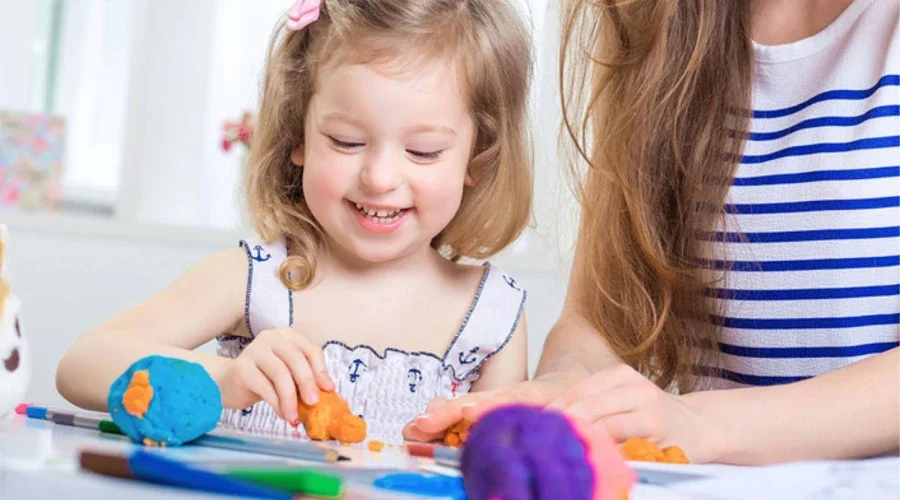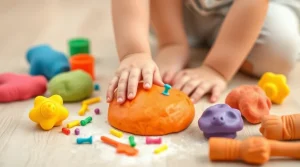
What Is Sensory Education in Montessori?
A complete guide to Montessori sensory education—how it refines perception, builds focus, and supports early development.
#1 Toys Manufacturer in China. WhatsApp: +86 180-0088-4063. Email: [email protected]
#1 Toys Manufacturer in China. WhatsApp: +86 180-0088-4063. Email: [email protected]

Child development isn’t just about school. It starts at home, often with a handful of playdough or a tray of kinetic sand. Toys aren’t just toys. They shape how kids think, feel, and relate to others.
A small child pressing shapes into air dry clay is doing more than having fun. They’re testing ideas, solving problems, and training their hands to work with their minds. These simple acts, repeated during play, become building blocks for bigger things later in life.
Imagine a 3-year-old stretching slime between her fingers. She’s not just making a mess. She’s learning about resistance, texture, and gravity—without knowing the words. Play, especially with hands-on materials like slime or playdough, gives kids direct feedback. They poke, mold, squish, and repeat.
In a 2018 report by the American Academy of Pediatrics, researchers noted that play “is fundamentally important for learning” and supports both cognitive and social development (Yogman et al., Pediatrics, 2018). Even 15 minutes of focused play with sand or clay helps develop planning skills and attention span.
A toddler doesn’t sit down to “practice executive function.” But when they build a tower from colored dough, then knock it over, they’re exploring cause and effect. That’s basic logic.
Jean Piaget, a pioneer in child psychology, argued that kids “construct” knowledge through active experience. So, when a child sculpts animals from air dry clay or builds roads in a bin of kinetic sand, they’re literally building understanding of the world.
Even unstructured play with slime or loose clay helps reduce mental load. The child isn’t being taught—they’re discovering. Over time, this helps build internal motivation, a key factor in lifelong learning.
The brain forms connections fastest in early childhood. Educational toys like puzzles, clay, and kinetic sand feed this growth through sensory input.
When children handle fine textures—rolling playdough or slicing soft slime with plastic tools—they activate multiple brain regions. Touch, movement, and visual cues combine to form stronger neural pathways. According to Harvard’s Center on the Developing Child, repeated experiences in play help “strengthen brain architecture” during these critical years.
A child sculpting a dinosaur from air dry clay might also be telling a story. In doing so, they’re linking memory, language, and imagination. It’s not a test—but it might be better than one.
Not every toy labeled “educational” actually contributes to learning. The term is often used loosely in marketing, but when examined closely, truly educational toys are designed with purpose—they challenge, engage, and nurture specific areas of a child’s development.
From building blocks to playdough tool sets, a real educational toy provides more than fun—it offers hands-on opportunities for thinking, experimenting, and imagining.
A real educational toy doesn’t just keep a child busy—it teaches without preaching. Here are the qualities to look for:
Toys like air dry clay or shape-matching puzzles fit these criteria because they adapt to different developmental levels and promote active learning.
>> How Does Kinetic Sand Work? The Science Behind It
Some toys look educational but don’t truly support learning. Here are common myths:
Children don’t just play—they grow through play. But not all toys are right for every age. As kids move through stages of development, their needs shift. The best educational toys are the ones that align with those stages—supporting learning without overwhelming or boring the child.
At this stage, kids are refining motor skills and starting to imagine big things. The best toys are colorful, hands-on, and flexible in use.
These toys also help preschoolers begin to follow instructions, problem-solve, and collaborate in play with others.
Children at this age crave challenge. Their attention spans are longer, and they begin to combine logic with imagination.
Toys that encourage experimentation and allow for step-by-step exploration are perfect for this stage.
Older children seek more autonomy in play. They often enjoy toys that let them explore concepts more deeply or express individuality.
At this age, children benefit most from toys that blend creativity, independence, and problem-solving.
Cognitive skills are the brain’s tools for learning—memory, reasoning, attention, and problem-solving. The best educational toys for cognitive development challenge children to think, make decisions, and solve problems in a playful, low-pressure way.
Instead of rote memorization or passive interaction, cognitive play thrives on discovery. When a child matches shapes, completes a puzzle, or figures out how to build a bridge from clay, their brain is actively making connections.
Some of the most effective cognitive toys are also the simplest:
Even a set of clay number molds can become a tool for early math learning, especially when paired with counting or problem-solving tasks.
Problem-solving toys tap into a child’s executive function—the ability to plan, remember instructions, and manage tasks. Neuroscientists have found that active play with challenge-based toys increases connectivity in the prefrontal cortex, the brain region responsible for decision-making.
For example, when a child experiments with different shapes to build a tower from kinetic sand or figures out how to sculpt a specific figure from air dry clay, they’re building logic pathways. These toys allow failure and retrying, which is crucial for cognitive growth.
Creativity isn’t just about art—it’s about thinking differently. Imaginative toys give children the freedom to express their ideas, test boundaries, and invent new worlds.
When children pretend, sculpt, or invent during play, they practice flexible thinking, emotional expression, and narrative building. The best educational toys for creativity don’t come with fixed rules—they come with possibilities.
Open-ended play materials like clay, slime, and kinetic sand are ideal for sparking creativity. They don’t demand a right answer—they invite exploration:
These toys act like blank canvases. Children project their thoughts, feelings, and curiosities into whatever they create.
Creative play helps children explore emotions in a safe way. When sculpting a “happy monster” or playing out a story with clay figures, they’re learning to identify, express, and regulate feelings.
Studies have shown that imaginative play improves empathy and emotional regulation. According to child development researchers, activities like pretend cooking with playdough or storytelling with clay figures help children practice perspective-taking—an essential part of emotional intelligence.
Sensory play goes beyond touch—it stimulates the brain through texture, movement, and feedback. It engages multiple senses at once, laying the foundation for more advanced learning.
Sensory-rich materials like slime, playdough, and kinetic sand give children a hands-on experience with cause and effect. They poke, squeeze, slice, and stretch—each action builds motor control and cognitive awareness. Sensory play is especially powerful for young children or those with sensory processing needs.
Tactile input plays a vital role in neural development. When children knead dough or run their fingers through kinetic sand, they’re building brain pathways related to motor coordination, attention, and sensory integration.
Studies show that tactile experiences activate regions of the brain responsible for fine motor control, especially in early childhood. This is why therapists often use sensory materials to support children with developmental delays.
Messy play may seem chaotic, but it supports structured growth. Handling sticky slime, squishy dough, or flowing sand allows kids to explore without fear of failure.
Here’s what messy play supports:
Messy materials offer immediate feedback, helping kids adjust actions and build confidence through trial and error.
Each sensory material brings unique learning benefits:
Using these materials in rotation gives children varied input, building a broader sensory vocabulary.
Children aren’t born knowing how to share, negotiate, or lead. These skills are learned—and often, they’re learned through play. Cooperative play is more than just fun with friends; it’s a foundation for social and emotional intelligence.
Educational toys that encourage group interaction help children understand others’ perspectives, manage emotions, and solve problems as a team. Whether in a classroom, a family setting, or a playdate, toys that support social learning lay the groundwork for empathy, communication, and leadership.
Not all toys are designed for solo play. Some are intentionally built to be shared:
Even a simple playdough bakery can become a team project—one child “bakes,” another “sells,” and a third “shops.” Through role-play, kids learn to listen, take turns, and express themselves clearly.
Toys that naturally involve turn-taking—like cooperative puzzles or storytelling dice—help children build patience and emotional regulation. These activities give children space to:
Games and activities designed with social balance in mind help reduce conflict and promote empathy. When children take turns molding a shared batch of slime or vote on how to decorate a clay creation, they’re practicing real-life emotional skills.
As technology and innovation shape the future, children need tools to build curiosity and confidence in science, technology, engineering, and math (STEM). Add art into the equation, and you get STEAM—a more holistic approach to learning that fosters creativity alongside logic.
STEM and STEAM educational toys invite children to experiment, ask questions, and discover how things work. These toys don’t give answers—they encourage exploration. And that’s what real learning is all about.
A STEM toy isn’t simply one that teaches math or science facts. Instead, it should:
For example, when a child uses clay to construct a bridge or mixes ingredients to make slime, they’re learning about material properties, structural integrity, and chemical reactions.
STEAM toys go a step further by merging creativity with structure. They support both sides of the brain:
Blending disciplines encourages flexible thinking. Children are more likely to transfer skills across subjects when they see how science, art, and logic intersect.
Through play, STEM and STEAM toys foster:
In an ever-changing world, these toys help children grow into problem-solvers, inventors, and creative thinkers.
Educational toys aren’t created in a vacuum. Many are inspired by well-established learning philosophies like Montessori, Waldorf, and Reggio Emilia. These methods shape how toys are designed, how they’re used, and what they aim to teach.
Each philosophy emphasizes a different aspect of child development—independence, imagination, or sensory exploration. Understanding these differences can help parents and educators choose toys that align with their values and their child’s needs.
Montessori toys are grounded in the idea that children learn best through independent, hands-on exploration. These toys are:
Montessori-aligned materials like dough sculpting tools, shape sorters, or number boards allow children to explore with focus and control.
Waldorf toys focus on open-ended imagination, emotional connection, and natural rhythm in play. Key features include:
A cloth doll, a wooden animal, or even a handmade clay figure—these are typical Waldorf-style toys meant to nurture imagination, not instruct.
>> What Is the Best Air Dry Clay for Beginners? A Friendly Guide
Every child is different. Some need more guidance; others thrive in open exploration. The best educational toys often blend philosophies—providing just enough structure to focus attention, while still allowing creative freedom.
For instance:
This balanced approach helps children develop a range of skills while honoring their individual learning styles.
Educational toys should promote growth—not pose a risk. While learning potential is key, safety is non-negotiable. Young children, especially, explore the world with their mouths and hands. This makes material choice and age-appropriate design essential.
Poor-quality or unsafe toys can cause physical harm, introduce toxic exposure, or discourage play altogether. That’s why parents, educators, and caregivers must look beyond function and consider what the toy is made of—and how it’s meant to be used.
Every region has its own toy safety regulations. In the U.S., for example, toys must meet standards set by:
Toys are typically labeled with a minimum age. These guidelines aren’t arbitrary—they reflect the risks of small parts, sharp edges, or even the complexity of play mechanics.
For example, air dry clay may be safe for ages 3+, while kinetic sand may require close supervision for younger users due to loose particles.
Educational toys are handled, squished, and sometimes even tasted—so what they’re made of matters.
Here’s what to look for:
Sensory toys like playdough, slime, or clay should clearly list their ingredients, especially if they’re homemade or customizable. Using safe, sustainable materials not only protects children—it teaches them to value health and the environment from an early age.
Not all educational toys yield visible results overnight. But over time, certain patterns and behaviors indicate meaningful progress. The best way to measure a toy’s effectiveness isn’t through test scores—it’s through observation.
When children return to the same toy again and again, explore it in new ways, or use it to express ideas, that’s a sign the toy is doing its job.
Educational toys support a range of skills, and different signs point to different types of growth:
Even the smallest change—like going from scribbles to shapes in playdough—can signal big leaps in development.
The best educational toys grow with the child. But even the most thoughtfully chosen toy may need to be adapted over time.
Observation helps adults respond not by replacing toys, but by reshaping the environment and prompting new types of play. Flexibility keeps the toy relevant and the child engaged.
The best educational toy isn’t a single product—it’s the one that meets a child’s developmental stage, sparks curiosity, and supports growth through meaningful play. By focusing on creativity, problem-solving, and safety, we empower children to learn through joyful discovery.
Not all electronic toys are educational. For a digital toy to support learning, it should encourage active engagement, critical thinking, or problem-solving—not just passive screen time or pressing buttons for lights and sounds.
Yes! Items like measuring cups, cardboard boxes, or fabric scraps can inspire learning. When children use these creatively, they explore concepts like size, balance, and sequencing through play.
Rotating toys every few weeks can renew interest and support different skills. It prevents boredom, highlights forgotten toys, and encourages children to explore in new ways.
Absolutely. Many educational toys—especially sensory or hands-on types—can be adapted for children with ADHD, autism, or learning delays. They offer non-verbal, accessible ways to explore and learn.
Adults guide, model, and enrich the learning process. Asking open-ended questions, encouraging exploration, and joining in can deepen a child’s understanding and make play more meaningful.
More Related...

A complete guide to Montessori sensory education—how it refines perception, builds focus, and supports early development.

Educational toys unlock creativity, problem-solving, and sensory skills—find out why they matter for every growing child.

From calming stress to building skills, see how sensory toys help children develop focus, creativity, and confidence through hands-on play.

What’s the best toy for child development? Learn how sensory toys shape young minds and bodies in early learning stages.

Our team will answer your inquiries within 48 hours.
Copyright © 2025 GuangDong AKIA Technology Co,. Ltd. All Rights Reserved